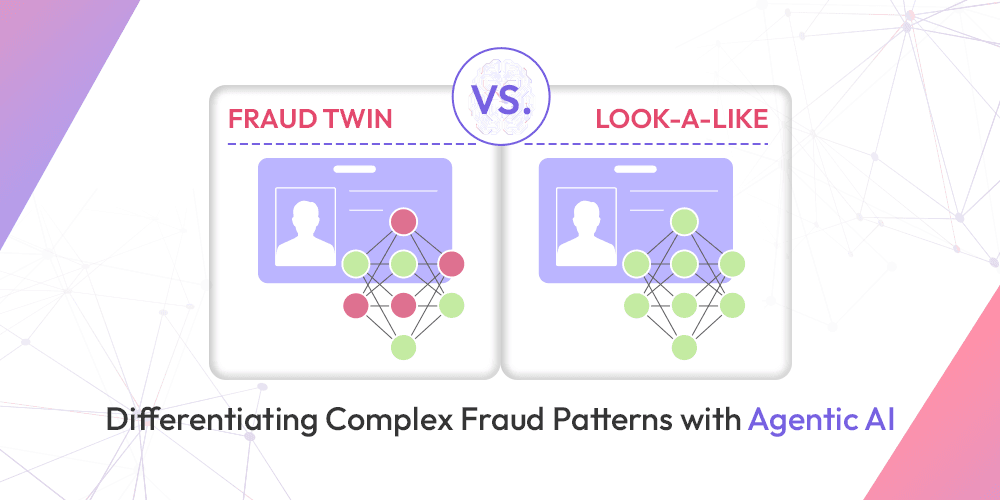
Fraud Twin vs Lookalike: Differentiating Complex Fraud Patterns with Agentic AI
RaptorX.ai
Thursday, September 11, 2025
Fraud in financial services has evolved from simple impersonation to highly sophisticated identity manipulation. Among the most challenging tactics are Fraud Twins and Lookalikes. At first glance, they seem similar, but their intent, behavior, and detection challenges are very different.
For AML teams and financial institutions, distinguishing between these two threats is no longer optional; it’s central to stopping laundering networks, preventing regulatory breaches, and protecting customer trust.
What is Lookalike Fraud?
Lookalike fraud is about surface-level similarity. Fraudsters create accounts or identities that closely resemble legitimate ones, hoping to pass initial checks.
Examples include:
- Personal details that nearly match an existing customer.
- Email or domain names designed to mimic trusted institutions.
- Accounts with overlapping KYC attributes (e.g., name, address, or partial SSN).
Lookalike attacks are dangerous because they exploit human and system perception. To the untrained eye, or a basic verification process, a lookalike appears genuine.
What is a Fraud Twin?
Fraud Twins go deeper than resemblance. Instead of only looking legitimate, they are engineered to act like legitimate customers. Fraud twins are often linked to:
- Two accounts with similar KYC or IP details, but diverging behaviors.
- Synthetic identities stitched together to mimic real customer attributes.
- Mule accounts that imitate typical transaction flows but are part of laundering networks.
The danger lies in their intent. A fraud twin doesn’t just resemble a customer; it mirrors their activities until the moment funds are siphoned off, making detection far more complex.
Why Differentiation Matters
The challenge for financial institutions is to separate legitimate overlap from malicious intent. Families may share IP addresses, employees may use the same corporate device, and genuine customers may have similar KYC profiles. Without deeper visibility, these can be mistaken for fraud, or worse, fraud twins can slip through unnoticed.
- Lookalike fraud deceives by appearance.
- Fraud twins deceive by intent and behavior.
Failing to differentiate between the two leads to either false positives (blocking legitimate clients) or false negatives (missing real fraud). Both outcomes are costly in terms of compliance and reputation.
The Logic Behind Fraud Differentiation
The key lies in combining pattern analysis, behavior analysis, and intent analysis:
- Pattern analysis reveals overlaps in KYC, devices, and IPs.
- Behavior analysis identifies abnormal payment flows, velocity spikes, or unusual account interactions.
- Intent analysis distinguishes whether an account’s purpose is aligned with legitimate use or tied to laundering rings.
When these layers are connected in a graph and network view, relationships become clearer. Investigators can see clusters of linked accounts, spot anomalies, and separate genuine activity from fraudulent intent.
How RaptorX Addresses Fraud: Twin vs Lookalike
RaptorX applies agentic AI to unify data across payments, devices, and accounts, enabling institutions to detect fraud in real time. Its core strength lies in graph neural networks (GNNs) and behavioral intelligence, which allow it to distinguish between similar-looking accounts and fraudulent twins.
1. Graph and Network Visibility
RaptorX builds connected views across accounts, IPs, SSNs, and devices. This allows AML teams to see when two accounts overlap on attributes but diverge in behavior.
Example: Two accounts log in from the same IP. One exhibits normal peer-to-peer transfers; the other routes funds rapidly across mule networks. The graph view highlights the difference instantly.
2. Pattern and Behavior Analysis
Fraud twins often attempt to mimic typical account activity. RaptorX continuously monitors transaction flows, velocity, and peer connections. Subtle deviations, like sudden transaction bursts or unusual counterparties, trigger early alerts.
3. Intent Analysis with Agentic AI
Beyond patterns, RaptorX focuses on intent. By examining how accounts interact within networks, the system identifies whether activity aligns with customer goals or with fraud rings attempting to launder money.
4. Graph Neural Networks (GNNs) for Detection
GNNs enable the platform to learn from relationships in the network, not just isolated data points. This is critical in spotting mule rings, synthetic identity clusters, and fraud twins hidden within legitimate customer groups.
5. Reduced False Positives
By analyzing intent and context, RaptorX can cut false positives by 40–50%, helping AML professionals focus on high-risk cases while avoiding unnecessary investigations of legitimate customers.
Why Graphs are Essential in Modern Fraud Detection
Graphs give AML professionals an investigative lens that goes beyond static data. They make fraud visible:
- Shared devices and IPs connect into clusters.
- Behavioral differences emerge within otherwise similar groups.
- Mule rings and laundering chains appear as distinct sub-networks.
For investigators, a graph is not just a tool; it is the difference between treating fraud twins as legitimate customers and stopping them at the first attempt.
Conclusion
Fraud twins and lookalikes represent two sides of modern financial crime: one rooted in resemblance, the other in mimicry of behavior and intent. Both are dangerous, but fraud twins are particularly insidious because they blend so deeply into customer ecosystems.
Financial institutions can no longer depend on surface-level verification. With agentic AI, graph and network analysis, behavioral intelligence, and GNN-powered detection, RaptorX enables AML teams to distinguish between legitimate overlaps, lookalikes, and fraud twins, reducing false positives while stopping fraud in real time.
In today’s financial landscape, the difference between fraud twins and lookalikes isn’t just a technical detail; it’s the line between resilience and vulnerability.

